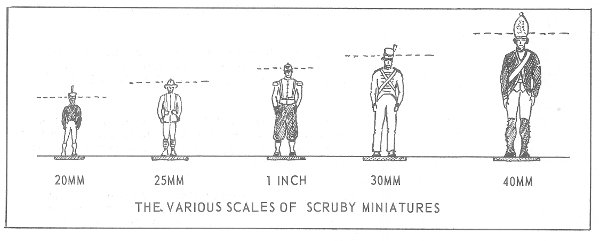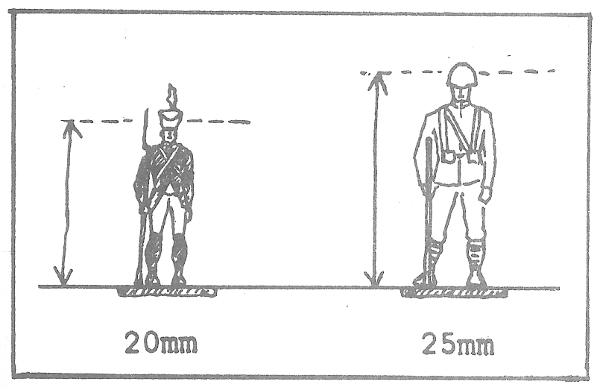Taking a break from Scruby catalouges…
My collection of books contains a number of titles covering the subject of model soldiers and collecting. One of the books I’ve used as a primary reference for figure sizes and scales is ‘Scale Model Soldiers‘ by Roy Dilley; published by Almark Publications. Publication date March 1972. This was one if the first books I found that nicely covered the differences of the various figures sizes and scales.
I’ve summarized the outline of the various figure sizes covered in this book. This guide is what I have used for the last 35 + years (I didn’t obtain my copy until the late 1970s).
The following is a listing of scales, with notes concerning each. Each is based on a human figure approximately 6 feet in height, of course we all know that men height, as such it is expected that models will vary slightly within any given scale. Naturally it is expected that the dimensions of equipment, vehicles, guns, and so forth, will be scaled to the given proportions:
20 mm or 3.5 mm to the foot (1:86 to 1:90 scale): This is the scale that matches HO gauge models for railroading. The Roco Minitanks are in this scale and match nicely with these figures.
25 mm, or 4 mm to the foot (1:76 to 1:72 scale): This is the scale that matches OO gauge railway models, and permits usage of OO scenic items.
30 mm, or 5 mm to the foot (1:60 scale): A utility scale, small enough for war gaming, and large enough to allow some level of fine detail found in ‘collectors’ figures. This is also the scale of most ’flat’ figures.
35 mm, or 6 mm to the foot (1:52 scale): Another utility scale… Les Higgins produced figures in this scale (does anyone know what was produced in this scale?
40 to 42 mm, or 7 mm to the foot (1:48 to 1:43 scale): Once considered too large for war gaming . This is another of the ‘railway’ scale, being equal to ‘O’ gauge.
54 mm, or 9 mm to the foot (1:32 scale): This is perhaps the most popular scale of all for collector and ‘toy’ soldiers.
77 mm, or 13 mm to the foot (1:24 scale): Typically very detailed metal figures. The only examples I know of (and have a few in my collection) are the ‘Series 77’ unpainted kits.
90 mm, or 15 mm to the foot (1:20 scale): Statuettes of typically outstanding quality and detail
I’ve not covered a few other scales that I have seen to be somewhat popular these scales or sizes are: 32mm and 120mm. The few 32mm figures I have had over the years would easily fit in with 30 or 35mm figures. I class the 120mm figure the same as 90mm figures, just to a larger scale. I have a few figures of this size in my collection, all are unpainted. Of course the 5/6mm , the 10/12mm and 15mm are not covered above and will need to be added when I next update my figures size definitions.
Off to see what more I can dig up in my book collection and in the ‘Scruby Archives’…


